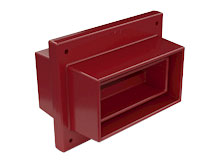Bushings

PIWB/PCYWB
- for indoor service
- air to air environment
- up to 15kV/95kV BIL
- single or multiple windows

PMT
- for indoor service
- air to oil environment
- up to 2.5kV/45kV BIL
- up to 3600 amps
- 2.14” – 4.00” below flange diameter

POB05
- for outdoor service
- air to air/oil environment
- up to 8kV/75kV BIL
- up to 3600 amps
- 3.50” below flange diameter

POBA
- for outdoor service
- air to air environment
- up to 46kV/250kV BIL
- up to 4000 amps
- 4.00''- 6.00'' below flange diameter

POBT
- for outdoor service
- air to oil environment
- up to 46kV/250kV BIL
- up to 5000 amps
- 4.00"- 6.00" below flange diameter

POFF
- for outdoor service
- air to oil environment
- up to 2.5kV/45kV BIL
- up to 6000 amps
- 3.00” – 5.00” below flange diameter

POMT
- for outdoor service
- air to oil environment
- up to 2.5kV/45kV BIL
- up to 3600 amps
- 2.14” – 4.00” below flange diameter

PSWB
- for indoor service
- air to air environment
- up to 28kV/150kV BIL
- 3.13” – 7.50” window diameter
What Are Bushings?
Electrical bushings are essential components for a wide range of electrical equipment such as transformers, shunt reactors and switchgears. These devices provide the necessary insulative barrier between the live conductor and conductive body of the electrical apparatus at ground potential. This critical function allows for bushings to carry current at high voltage through the conductive barrier of equipment enclosures. Polycast bushings are designed to prevent electrical failure from flashover or puncture, to limit heat rise with the current rating, and to withstand mechanical forces from cable load and thermal expansion.
The internal insulation of a bushing must withstand the electrical stresses it will endure in service. These stresses are caused by the voltage potential difference from the energized conductor to the grounded components the bushing passes through. In medium and high voltage applications, the internal insulation must also limit the inception of partial discharge (PD) which could progressively degrade the properties and ability of the insulation.
A bushings external insulation has specific design elements such as number of sheds and creepage distance to provide separation between the energized HV connection points and the ground potential on the outside of the part. The purpose of these features is to prevent dry arcing (flashover) and creep (leakage). Dry Arcing, rated by BIL, requires sufficient distance for the busing to withstand electric impulses from switching and lightning strikes. These events can cause a flashover failure where an electric arc forms from the HV conductor directly to ground if the distance is insufficient for the voltage. Creep (Leakage) occurs when contamination builds up on the surface of the bushing and provides a conductive path for current to follow along the surface. Inclusion of sheds in bushing design effectively increases surface distance of the bushing between the HV terminal and the ground to prevent creepage losses.
Polycast manufactures indoor & outdoor epoxy bushings for switchgear, transformer & power apparatus applications at both low and medium voltage classes. Our Bushings are designed and tested to meet applicable CSA, IEC, NEMA, and IEEE standards.
Low Voltage Bushings are rated for voltages up to 5kV/60kV BIL and Medium Voltage bushings are rated for voltages up to 46kV/250kV BIL.
Polycast manufactures Epoxy bushings, which is the perfect substitute for Porcelain Bushings and has many advantages. See our article on Epoxy Bushings vs Porcelain Bushings
Bushings for Switchgear
Bushings provide the essential insulation when a high voltage line passes through a metal sheet or frame that is at ground potential. Primary Disconnect Bushings are the key components of the switchgear that serve as the connection points to energize the network downstream of the switchgear. Primary Disconnect Bushings are always exposed to applied voltage within the Switchgear. Therefore, they are the most likely to be the first element to explore electrical breakdown between the enclosed conductor and the earthed metalwork surrounding it.
Bushings for Transformers
A transformer bushing is an insulating device that allows an energized, current-carrying conductor to pass through the transformer's grounded tank. A Bar-Type Bushing has the conductor built in, whereas Draw-Lead or Draw-Rod Bushing have the provision for a separate conductor to be installed through its centre. Solid (bulk type) bushings and capacitance-graded bushings (condenser type) are the two main forms of bushing construction:
- Solid bushings with a porcelain or epoxy insulator are commonly used as the connection points from a transformer's low voltage winding side to outside of the transformer.
- Capacitance-graded bushings are used at higher system voltages. Compared to solid bushings, they are relatively complex in their construction. To cope with the high electric field stresses generated at higher voltages, capacitance-graded bushings are equipped with an inner capacitance-graded shield, which is embedded between the central current carrying conductor and external insulator. The purpose of these conductive shields is to reduce partial discharge by management of the electric field around the center conductor, so that the field stress is concentrated evenly within the bushing insulation.
Polycast: Your Trusted Bushing Manufacturer
Polycast is a leading manufacturer of high-quality electrical bushings, essential components in a wide range of electrical equipment, including transformers, shunt reactors, and switchgears. Our bushings play a critical role in ensuring the safe and efficient operation of electrical systems by providing a reliable insulative barrier between live conductors and grounded components.


